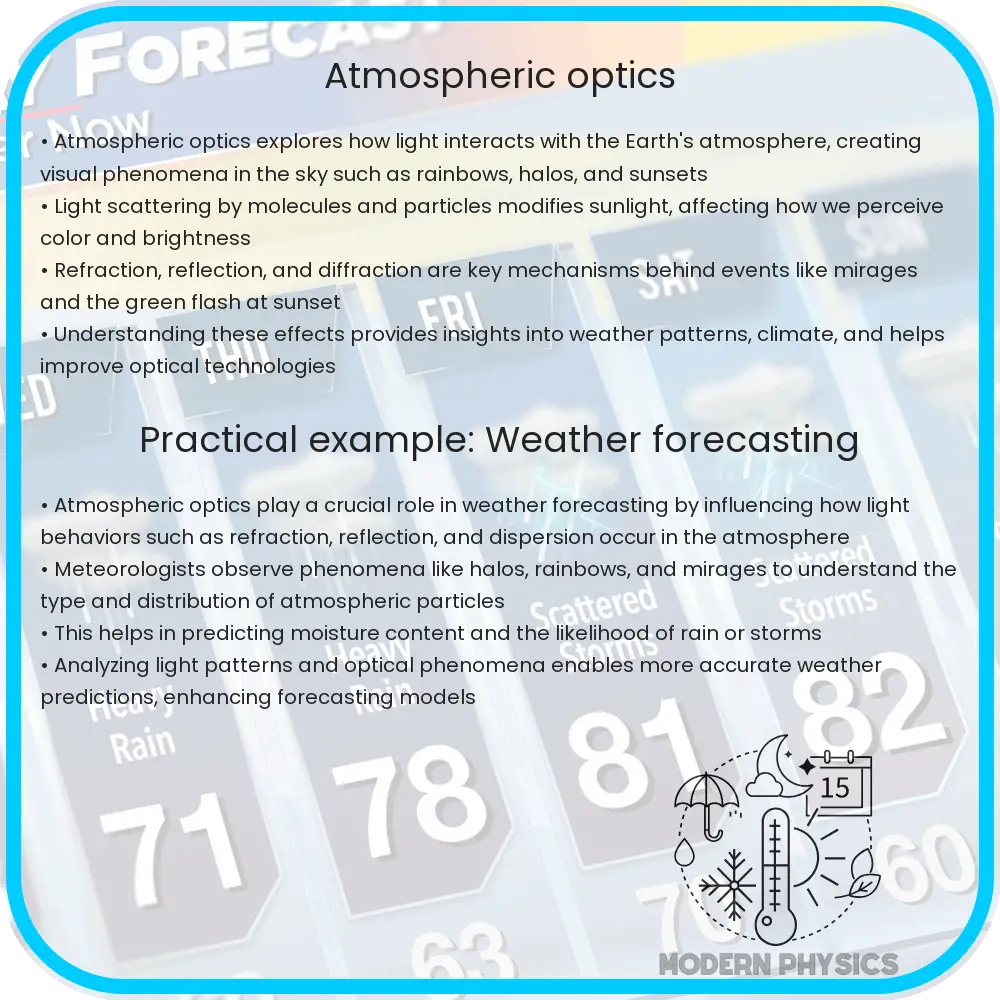Atmospheric optics studies light interaction with Earth’s atmosphere, creating phenomena like halos, rainbows, and glories.

Exploring the Wonders of Atmospheric Optics: Mystical Halos, Rainbows, and Glories
Atmospheric optics, a fascinating branch of physics, involves studying how light interacts with the Earth’s atmosphere, producing stunning visual phenomena such as halos, rainbows, and glories. These intriguing optical illusions occur due to the reflection, refraction, and scattering of light — effects that illuminate our skies with spectacular displays of color and form.
Mystical Halos: Circular Rainbows of Light
Halos are circular bands of light which often encircle the sun or moon and are typically seen when thin, high-altitude cirrus clouds containing ice crystals interact with light. The ice crystals bend (or refract) direct sunlight or moonlight, usually at a minimum deviation angle of 22 degrees, creating what is commonly known as a 22-degree halo. This phenomenon can also create larger halos at 46 degrees, although these are rarer and less vivid.
- Formation Process: When light passes through the hexagonal ice crystals, it is refracted at a 22-degree angle, which focuses the light into a ring. Each ice crystal acts like a miniature prism, contributing to the overall effect seen by an observer on the ground.
- Color and Appearance: While halos can appear as a white ring, they often display a reddish inner edge with colors fading to bluish on the outer edge due to the variable refraction of different wavelengths of light.
Radiant Rainbows: A Spectacle of Light and Color
Rainbows are one of the most delightful atmospheric phenomena, forming when sunlight strikes raindrops and undergoes refraction, reflection, and dispersion. Sunlight enters a raindrop, slows down and bends as it goes from air to denser water, separates into different colors, and reflects off the inside surface of the drop. When exiting the drop, it bends again and continues to disperse into a spectrum of colors.
- Primary Rainbow: This occurs at an angle of about 42 degrees to the original path of sunlight. It shows a red band on the outer part and violet on the inner side.
- Secondary Rainbow: Occasionally, a second, dimmer rainbow forms outside the primary bow. This is due to two reflections inside the raindrop and appears at an angle of about 51 degrees, with its colors inverted compared to the primary rainbow.
Glories: The Observer’s Circular Rainbow
Glories are often observed from airplanes or high mountaintops looking down onto a cloud or fog with the sun behind the observer. They appear as small, circular rainbows surrounding the shadow of the observer projected onto the cloud. This phenomenon occurs due to backscattering of light, with water droplets acting as the scattering agents.
- Mechanism: Light is scattered backward towards its source by individual droplets via wavefront division and interference, a complex process that involves both diffraction and a sharp angle of backward scattering.
- Visual Features: Glories typically display multiple colored concentric rings, with the order being red on the outside and violet on the inside. The colors of a glory are much purer than those of a rainbow due to the more pronounced splitting of light by wavelengths.
Each of these phenomena not only beautifies our natural world but also helps scientists understand the intricate interactions between light and the atmospheric particles. These light shows also provide insights into the composition, structure, and behavior of our atmosphere.
Further Insights into Atmospheric Optics
Aside from halos, rainbows, and glories, the atmosphere is capable of producing other less common but equally mesmerizing optical phenomena such as mirages, the green flash, and the aurora. Each of these phenomena provides additional clues about the atmospheric conditions and the interplay of light with different particles.
- Mirages: Often seen in deserts or on hot roads, mirages are images of distant objects distorted or displaced due to the refraction of light in layers of varying air density, usually caused by temperature gradients.
- Green Flash: This rare occurrence can be seen briefly at sunrise or sunset. It happens when the Earth’s atmosphere causes the light from the Sun to separate out into different colors more prominently.
- Auroras: Known as the Northern or Southern Lights, auroras are spectacular natural light displays in the Earth’s sky, typically observed in the high-latitude regions around the Arctic and Antarctic, caused by the collision of energetic charged particles with atoms in the high altitude atmosphere.
Conclusion: The Magic of Atmospheric Optics
Atmospheric optics is a rich field that blends the beauty of natural light displays with the complexities of scientific phenomena. Each event, from the common rainbow to the elusive green flash, enhances our appreciation for the Earth’s atmosphere. Moreover, these phenomena encourage scientists and observers alike to learn more about physics and the world around us.
Understanding how light interacts with atmospheric particles not only satiates curiosity but also enriches our understanding of meteorological and environmental conditions. As we continue to study these beautiful displays of nature, we gain more insights into not just our planet’s present climate system, but also its future changes. For enthusiasts and experts, the skies remain a magnificent canvas, colored by the physics of light and matter.
